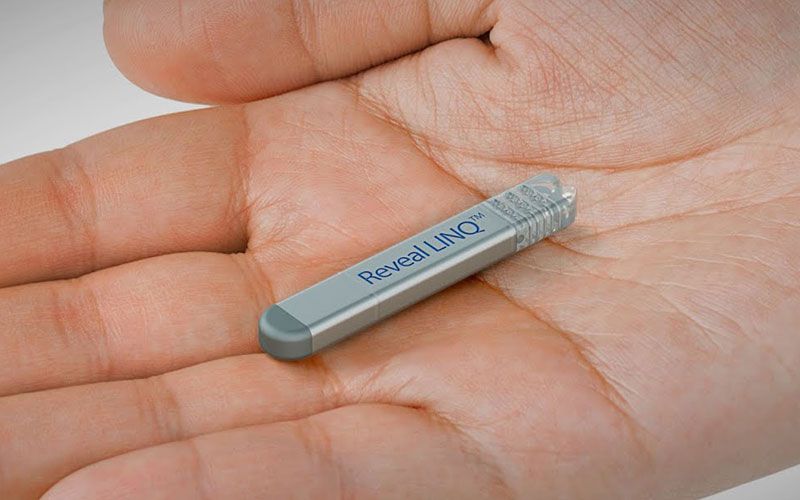Pair of Trials Demonstrate Reveal LINQ's Ability to Improve Detection of Atrial Fibrillation
Simultaneously published in JAMA, the PER DIEM and STROKE-AF trials demonstrate the ability of Medtronic's insertable cardiac monitor, Reveal LlNQ, to improve detection of atrial fibrillation in patients with a history of stroke.
Image provided by University of Alberta

Data from a pair of studies simultaneously published in JAMA provide support for use of Medtronic’s Reveal LINQ device for detection of atrial fibrillation (AF) in multiple patient populations.
Results of the PER DIEM and STROKE-AF trial indicate use of the insertable cardiac monitor (ICM) outperformed prolonged external monitoring in patients with ischemic stroke and also outperformed usual care for detecting AF in patients with stroke attributed to large- or small-vessel disease.
"We know that (the current method of monitoring) isn't as effective as it could be in picking up atrial fibrillation from this study because regardless of which arm of the study patients went into, we were picking up anywhere from five to 15% extra atrial fibrillation," said Brian Buck, MD, a stroke neurologist and associate professor of medicine at the University of Alberta and investigator of the PER DIEM trial, in a statement. "We found in the study there were a lot of patients with undetected atrial fibrillation, even after they received the standard cardiac monitoring."
PER DIEM
PER DIEM was an investigator-initiated, open-label, randomized clinical trial performed in a population of 300 patients from 3 medical centers in Alberta, Canada. Patients included in the trial were randomized in a 1:1 ratio to prolonged external monitoring with Reveal Linq or an external loop recorder for 12 months. All patients included in the trial underwent enrollment within 6 months of ischemic stroke and had no known AF.
The primary outcome of the trial was development of definite or highly probable AF. Follow-up visits occurred at 30 days, 6 months, and 12 months. The trial also included 8 secondary outcomes, such as recurrent ischemic stroke, death, intracerebral hemorrhage, and device-related serious adverse events.
Upon analysis, results indicated the definite or highly probable AF was detected in 15.3% (n=23) of patients in the ICM group and 4.7% of patients in the external loop recorder group (between-group difference, 10.7% [95% CI, 4.0-17.3%]; risk ratio, 3.29 [95% CI, 1.45-7.42]; P=.003). No statistically significant risk was observed for 6 of the 8 secondary outcomes included in the trial.
In a post hoc analysis with a broader definition of AF, detection of AF at 12 months was 20.7% among those in the ICM group compared to 5.3% in the external loop recorder group (between-group difference, 15.3% [95% CI, 7.9-22.7%]; RR, 3.88 [95% CI, 1.84-8.15], P = .001).
STROKE-AF
STROKE-AF was designed with the goal of determining whether use of ICMs could improve detection of AF versus usual care in patients with ischemic stroke attributable to large- or small-vessel disease. STROKE-AF randomized 492 patients to ICM or usual care. All patients enrolled in the study were followed for 12 months.
For inclusion in the trial, patients needed to be at least 60 years of age or 59 years of age with at least 1 additional stroke risk factor. Additionally, ICM devices were implanted within 10 days of the index stroke event.
The primary outcome of the study was incident AF lasting more than 30 seconds. Upon analysis, AF detection at 12 months was significantly greater in the ICM group compared to the control group (12.1% vs 1.8%; HR, 7.4 [95% CI, 2.6-21.3]; P <.001). Safety analysis in this trial indicated procedure-related events occurred in 1.8% of patients, with 1 site infection, 2 incision site hemorrhages, and 1 instance of implant site pain reported within the trial.
While investigators of the trial noted results demonstrate the benefits of ICM for detecting AF, they also called for further investigation to determine whether the identification of AF in these patients improves clinical outcomes.
"Based on the study findings, we believe that patients with stroke who are similar to those in the STROKE AF Trial should now undergo long-term cardiac monitoring with an insertable cardiac monitor to identify unsuspected atrial fibrillation,” said senior investigator Lee Schwamm, MD, C. Miller Fisher Chair of Vascular Neurology at Massachusetts General Hospital, in a statement.
These studies, ”Effect of Implantable vs Prolonged External Electrocardiographic Monitoring on Atrial Fibrillation Detection in Patients With Ischemic Stroke,” and “Effect of Long-term Continuous Cardiac Monitoring vs Usual Care on Detection of Atrial Fibrillation in Patients With Stroke Attributed to Large- or Small-Vessel Disease,” was published in JAMA.